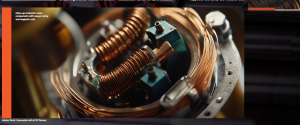Europe’s ambitious climate goals demand transformative innovations across multiple sectors. As the shift toward electrification accelerates, electric motors have emerged as critical enablers in reducing emissions and supporting the energy market transition.
While they offer environmental benefits over conventional engines, electric motors still face trade-offs in performance, weight, efficiency and reliance on rare earth elements (REEs). Today, most high-performance motors depend on REE-based permanent magnets, many of which are sourced from outside Europe, posing strategic and environmental risks.
Conventional manufacturing of electric motors faces limitations in terms of flexibility, efficiency and material usage, particularly due to its reliance on rare earth elements (REEs) such as neodymium and dysprosium. These limitations result in heavier, less efficient motors and rigid production processes.
To tackle these challenges, the MultiMag project is leading a holistic innovation approach that integrates advanced materials, multi-material additive manufacturing (MM-AM) and circular design principles to deliver the next generation of efficient, sustainable electric machines.
MM-AM offers a promising alternative by enabling the creation of complex, optimised structures, such as three-dimensional (3D) flux paths and lighter rotors, which are not possible with traditional lamination techniques. MM-AM also opens new design possibilities at both macro and micro scales, enhancing motor performance and reducing material usage.
The MultiMag vision
The primary objective of the MultiMag project is to develop multifunctional, multi-material components for electric machines utilising MM-AM. The project aims to dramatically improve motor performance, reduce weight, shorten manufacturing lead times and enhance recyclability. At the end-of-life stage, the components will be designed for disassembly and recovery of valuable materials such as REEs, reinforcing Europe’s raw materials resilience.
Quantitative targets include:
- 50% mass reduction in magnets
- 20% weight reduction in inactive motor components
- 30% improvement in overall performance
- 20% lead time reduction in rotor manufacturing
- 20% increase in energy efficiency
- more than 60% recyclability rate of REEs.
What sets MultiMag apart?
MultiMag takes a truly integrated approach to innovation. The project not only advances additive manufacturing techniques but also co-develops high-performance materials (soft magnets, permanent magnets, insulators, structural materials), smart design methodologies and novel recycling technologies.
Key technical highlights
The project’s technical highlights include:
- design tools and simulations optimised for MM-AM and complex multi-physics challenges
- development of functional multi-material structures combining magnetic, insulating and structural elements
- process optimisation across three MM- AM technologies: powder bed fusion- laser beam (PBF-LB), binder jetting (BJT) and sheet lamination (SHL)
- novel methods for REE recovery, including green leaching and oxide reduction.
Use cases
To ensure practical relevance and industrial adoption, MultiMag focuses on three real-world electric motor use cases.
Use case 1 – General-purpose induction/ reluctance motors
Applications: industrial automation, pumps, fans, compressors
These motor types are commonly used across many industrial sectors and play a major role in electricity consumption. Even small efficiency gains can significantly reduce energy use and associated emissions.
In this use case, multi-material sheet lamination technology and binder jetting are used to enhance rotor and stator components. The goal is to improve motor efficiency and reduce energy losses and component weight.
By replacing conventional assembly methods with advanced MM-AM, the design becomes more flexible and performance-oriented.
Use case 2 – Synchronous permanent magnet brushless motor
Applications: e-mobility and automotive
This innovative motor features axially aligned stator poles and is designed for improved torque and better cooling.
MM-AM allows for complex geometries, including internal cooling channels not achievable through traditional manufacturing. This enhances the motor’s thermal management, efficiency and material use.
The design supports improved recyclability and reduced dependence on critical raw materials like REEs, while also lowering the overall weight and cost of the motor.
Use case 3 – Multipurpose electrical rotary actuator
Applications: space industry (New Space market)
Hybrid stepper motors used in space applications often require high precision and have been difficult to produce affordably in small volumes.
Through MM-AM, this use case enables the low-cost, customisable production of these motors, suitable for different mission needs without incurring high tooling costs.
The new approach enhances manufacturing efficiency by utilising more of the raw material, minimising waste and facilitating design flexibility. These features are critical for the aerospace sector, where performance, weight and cost all play vital roles.
Applications and impact
The implications of MultiMag stretch across multiple high-impact industries:
- mobility and e-mobility – lighter, more efficient motors can reduce vehicle weight and increase range
- industrial automation – enhanced motor performance supports precision manufacturing and energy savings
- aerospace and space – lightweight actuators designed with MM-AM open new possibilities for space exploration technologies
- sustainability – improved recyclability and reduced REE usage align with the EU’s strategic autonomy and circular economy goals.
MultiMag is paving the way for more sustainable, efficient and resilient electric motor technologies in Europe. By developing advanced MM-AM processes and sustainable magnetic materials, the project significantly reduces its reliance on critical raw materials, such as REEs. Its innovations lead to lighter, higher-performing electric motors with shorter production lead times and improved recyclability.
MultiMag supports Europe’s green and digital transition, strengthens circular economy practices and enhances competitiveness, particularly in key sectors such as mobility, aerospace and energy. Through collaboration with SMEs and key industry players, MultiMag helps secure Europe’s leadership in next-generation electrification technologies.
Looking ahead
As the MultiMag project progresses, the next phase focuses on manufacturing demonstration components for the defined use cases and testing them in industrially relevant environments. The project also continues to build a framework for stakeholders, facilitating the adoption of MM-AM and promoting collaboration across Europe’s industrial ecosystem.
With its unique blend of innovation, sustainability and industrial relevance, MultiMag is setting a benchmark for the future of the electric motor industry—one that is smarter, greener and fully aligned with Europe’s climate ambitions.
The consortium sees clear exploitation potential in the results, not only to improve the performance of current motors, but to develop new products for existing and new markets. Motors that will use less REE materials and provide improved power-to-weight ratio, leading the way towards a more sustainable Europe.
MultiMag consortium
The MultiMag project is coordinated by VTT Technical Research Centre of Finland Ltd. The consortium is made up of 12 partners from nine different countries with a wide geographical distribution across the European continent. It is bringing together raw material suppliers, end-users, and research and technology organisations (RTOs) for the joint development of novel solutions in the field of magnetic applications and electric machines. Participants from all parts of the value chain enable rapid development and industry adoption. It consists of three industrial, highly recognised electric machine original equipment manufacturers (OEMs), two magnetic material suppliers, four international RTOs and universities, and three SME research actors focusing on sustainability, recycling, communication, dissemination and exploitation.
For more information on the MultiMag project
Title: Multi-functional, multi-material magnetic components and structures for electrification
Visit: multimag-project.eu
Project summary
MultiMag is an EU-funded project which leverages multi-material additive manufacturing to develop advanced rotor and stator structures, optimising performance and reducing material use. Through innovations in design, materials, production and lifecycle management, the project delivers lightweight, efficient electric motor components with minimised reliance on REEs.
Project partners
The MultiMag consortium comprises partners from nine different countries, with a wide geographical distribution across the European continent. It brings together raw material suppliers, end-users, and RTOs for the joint development of novel solutions in the fields of magnetic applications and electric machines.
Project lead profile
VTT is one of the leading RTOs in Europe, owned by the Finnish state, with an 80-year track record of solving global challenges through science and technology, and turning them into opportunities for the betterment of society and companies. They advance the utilisation and commercialisation of research and technology in commerce and society.
Project contacts
Project Coordinator: Pasi Puukko, Senior Scientist, VTT
Email: Pasi.Puukko@vtt.fi
Linkedin: MultiMag project
Funding disclaimer
Funded by the European Union. Views and opinions expressed are however those of the author(s) only and do not necessarily reflect those of the European Union or the European Health and Digital Executive Agency. Neither the European Union nor the granting authority can be held responsible for them. Grant Agreement No. 101091392.
Figure legends
Close-up of electric motor components with copper wiring and magnetic coils.


